When the seasons change, your mood can shift in ways that feel overwhelming. For many, shorter days and darker months bring more than just low energy. Seasonal affective disorder and addiction often appear together, creating challenges that feel hard to manage alone. Some people turn to substances to cope with depression or anxiety linked to seasonal changes, but this can quickly worsen both conditions. You don’t have to face this cycle on your own. Support and treatment are available to help you break free. Professional programs can address both mental health and substance use at the same time, which is key for real healing. If you or someone you care about is struggling, exploring options like drug and alcohol rehab in West Virginia can be a life-changing step forward.
Seasonal Affective Disorder and Addiction: Dual Struggles
Seasonal affective disorder and addiction are deeply connected, often creating challenges that feel overwhelming. Many people living with seasonal affective disorder and substance abuse experience symptoms that drive them toward unhealthy coping habits. These habits can quickly lead to dependence, making recovery harder. To fully understand how seasonal affective disorder leads to addiction, it’s important to look at co-occurring disorders, the role of mental health, and the cycle of depression mixed with substance dependence.

Why Co-Occurring Disorders Are Common
Living with seasonal affective disorder and addiction is often tied to what’s called co-occurring disorders. That means a person struggles with both mental health issues and substance use at the same time. When depression deepens during seasonal changes, the risk of self-medicating grows. This pattern explains how seasonal affective disorder leads to addiction for many people who want quick relief. Before long, both conditions feed into each other.
When you know the signs of co-occurring disorders, it becomes easier to get the right support. Here are the most common connections you’ll notice between seasonal affective disorder and substance abuse:
- Increased alcohol use: People drink to lift their mood but often feel worse afterward.
- Drug misuse: Substances like opioids or stimulants may seem helpful but increase risk.
- Worsening depression: Addiction intensifies mood swings linked to seasonal depression.
- Loss of control: Struggles with both conditions spiral without proper treatment.
- Delay in seeking help: Many people don’t recognize the link until it’s severe.
Mental Health Challenges That Worsen Addiction Risk
Seasonal affective disorder and addiction are harder to manage when other mental health struggles are present. Anxiety, unresolved trauma, or long-standing depression can make seasonal depression feel heavier. When a person wonders, can you get seasonal depression in the summer, the answer is yes. SAD can appear in both winter and summer, and either form can raise the chance of using substances as a coping method.
These mental health challenges complicate recovery because they often go unnoticed or untreated. People turn to drugs or alcohol to cover symptoms like fatigue, restlessness, or isolation. Unfortunately, this temporary relief feeds the addiction cycle. Learning how seasonal affective disorder leads to addiction means recognizing that mental health symptoms cannot be ignored. Effective treatment must focus on both the emotional struggles and the addictive behaviors driving the problem.

The Cycle of Depression and Substance Dependence
When seasonal affective disorder and addiction overlap, a destructive cycle often begins. A person feels low energy, sadness, or hopelessness during darker months. They may use alcohol or drugs to feel better, but the relief is temporary. Soon, dependence develops, leading to more depression. Over time, this cycle makes both seasonal affective disorder and substance abuse stronger. That’s how seasonal affective disorder leads to addiction in many lives.
Breaking this cycle requires professional treatment. A partial hospitalization program West Virginia residents use can provide structure, daily therapy, and medical support without full-time hospitalization. This level of care helps address both conditions at once, giving people strategies to manage seasonal triggers while tackling substance use. Without help, the cycle repeats itself every season, making recovery harder. With the right plan, healing and long-term stability are possible.
Signs You May Be Facing Both Conditions
It’s not always easy to know when seasonal affective disorder and addiction are happening together. Many people notice small changes at first, but those signs often grow stronger with time. Recognizing them early can make it easier to get proper help. If you’re unsure, these common warning signs can help you understand if you might be facing both conditions:
- Mood swings: Depression increases during darker months, and substances worsen the cycle.
- Withdrawal from others: Isolation becomes more common as symptoms and substance use grow.
- Increased alcohol or drug use: Substances are used as a coping method but create bigger problems.
- Daily routine disruption: Sleep, eating, and energy levels change dramatically.
- Trouble functioning: Work, relationships, and personal responsibilities start to decline.

Treatment and Rehab for Seasonal Affective Disorder and Addiction
Finding the right treatment for seasonal affective disorder and addiction is the turning point toward recovery. Many people dealing with seasonal affective disorder and substance abuse need care that focuses on both issues together. If you’ve seen how seasonal affective disorder leads to addiction in your own life, you know quick fixes don’t work. The best results come from rehab programs that treat the whole person, addressing mental health and addiction together.
Why Integrated Care Matters for Recovery
Seasonal affective disorder and addiction require an approach that doesn’t separate the conditions. Integrated care means addressing mood changes, depression, and substance use in the same plan. This reduces the risk of relapse and helps build healthier habits that last year-round. Without treating both, symptoms return, and the cycle continues. That’s why professional help is so valuable for lasting change.
For many, cost is a concern, but programs now work with different coverage options to make treatment accessible. For example, PEIA insurance rehab coverage can reduce the financial stress of treatment. This makes it possible for people to get the care they need without waiting until their condition worsens. Recovery becomes more realistic when care for both mental health and substance use is combined and affordable.
Therapies That Address Both SAD and Addiction
When looking for support, you’ll find that therapy plays a central role. Seasonal affective disorder and addiction are both linked to mood, habits, and thought patterns. Treatment programs often include light therapy, daily structure, and counseling. These therapies target symptoms of seasonal depression while also reducing the urge to use substances. This combined method is key to breaking the cycle.
One of the most effective treatments is cognitive behavioral therapy for substance use disorders. CBT teaches practical tools to change negative thought patterns and replace unhealthy coping methods. With regular practice, people learn how to manage seasonal depression triggers without relying on drugs or alcohol. When combined with other therapeutic options, it becomes easier to manage both seasonal affective disorder and substance abuse in a healthier, sustainable way.

The Role of Professional Rehab Centers in Dual Diagnosis Treatment
Rehab centers are often the safest place to treat both seasonal affective disorder and addiction. These facilities offer a structured environment where medical professionals and therapists work together to provide care for both conditions. This approach is called dual diagnosis treatment. It looks at the whole person, not just one part of their struggles.
Many people delay seeking help because they believe their seasonal depression will pass. However, seasonal affective disorder and substance abuse often worsen without treatment. A dual diagnosis treatment West Virginia program can provide care that addresses both the mental health side and the addiction side at the same time. Professional rehab gives people tools to break the cycle and rebuild their lives, especially when seasonal changes make everything feel harder.
Support Systems and Long-Term Recovery
Recovery from seasonal affective disorder and addiction does not end when treatment ends. It’s about creating a plan for long-term stability and learning how seasonal affective disorder leads to addiction so that relapse risks can be reduced. Seasonal affective disorder and substance abuse often return during darker months if there’s no plan. Building strong support systems, healthy habits, and relapse prevention tools helps people continue progress long after formal treatment.
How Family and Friends Can Help
Family and friends play a huge role in long-term recovery from seasonal affective disorder and addiction. When people feel supported, they’re less likely to fall back into unhealthy coping patterns. Loved ones can help by staying informed, encouraging healthy habits, and being present when symptoms return. Their role is not to fix everything but to stand as a steady source of strength and accountability.
Here are practical ways family and friends can make a difference:
- Learn the signs: Know when depression and substance use symptoms worsen.
- Encourage treatment: Support participation in therapy or medical care.
- Offer stability: Create routines that reduce seasonal stress.
- Avoid judgment: Show empathy rather than criticism.
- Stay connected: Keep regular contact to reduce feelings of isolation.

Preventing Relapse During Seasonal Shifts
Relapse is a real risk for anyone dealing with seasonal affective disorder and addiction. When days get shorter, or when stress increases, the urge to return to substances can grow. That’s why relapse prevention planning is so important. Programs teach people how seasonal affective disorder leads to addiction and then help them prepare for seasonal changes before they happen.
Therapies that build coping skills can make this shift easier. One example is art therapy rehabilitation, which provides a creative outlet to manage emotions. Activities like painting, music, or writing reduce stress and help process feelings without turning to substances. Combined with other tools like exercise, sleep routines, and therapy, relapse prevention becomes stronger. With planning and support, recovery can continue even during the most challenging seasonal shifts.
The Value of Group Therapy and Peer Support
Seasonal affective disorder and addiction are easier to manage with peer support. Group therapy connects people who share the same challenges, making recovery feel less isolating. Hearing others talk about how seasonal affective disorder leads to addiction helps people see they aren’t alone. These sessions provide encouragement, accountability, and a chance to learn new coping strategies.
Therapies like dialectical behavior therapy for addiction are often included in group sessions. DBT helps with emotional regulation, stress management, and healthier responses to seasonal triggers. Combined with peer support, these tools give people the confidence to handle seasonal affective disorder and substance abuse long-term. Building connections with others creates a sense of belonging that can protect against relapse and keep recovery on track throughout the year.

Coping Strategies for SAD Without Substances
When seasonal affective disorder and addiction connect, it’s important to learn new ways to cope. Turning to alcohol or drugs may feel like short-term relief, but it makes recovery harder. Healthy coping strategies give you tools to manage seasonal symptoms without falling back into harmful habits. Here are some proven options you can start trying right away to support yourself:
- Light therapy: Daily light exposure reduces symptoms linked to seasonal depression.
- Exercise: Physical activity lifts mood and boosts energy levels.
- Balanced diet: Nutritious meals help stabilize mood changes.
- Sleep schedule: Regular sleep patterns reduce fatigue and mental stress.
- Therapy sessions: Talking with a counselor builds stronger coping tools.
- Social connection: Staying connected reduces isolation and loneliness.
- Structured routine: Consistency helps maintain stability through seasonal shifts.
Reach Out and Begin Your Recovery Journey
Seasonal affective disorder and addiction can make life feel heavier when you’re already struggling. The mix of depression and substance use often creates a cycle that feels impossible to break alone. But recovery is possible with the right help. Treatment that focuses on both mental health and addiction gives you tools to manage seasonal changes without turning to substances. You deserve support, and taking that first step can bring relief and hope. If you’re ready to explore treatment options and want a safe place to heal, our team is here to help. Don’t wait for things to get worse when real change is possible now. Take control of your future and contact us.



